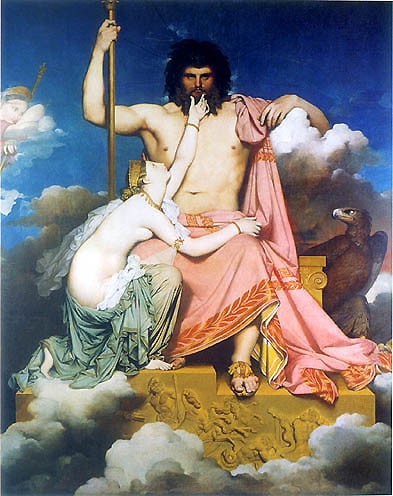In 1811, whilst still a young student at the Académie de France in Rome, Ingres finished this monumental painting entitled 'Jupiter and Thetis', which he presented at the Paris Salon the following year. The work was a reply to the harsh criticism which his portrait of Napoleon had received at the Salon of 1806. The episode is taken from Homer's Iliad: the nymph Thetis, mother of Achilles, is imploring Jupiter to resolve the conflict between her son and Agamemnon, the leader of the Greek expedition to Troy – Jupiter's wife, Juno, looks on from afar. The references to the Napoleon portrait are however clear. The embodiement of the supreme leader, Jupiter, is the double of Napoleon, he has the same hieratic pose as the all-powerful emperor and has the same attributes – throne, sceptre, mantle and eagle (next to the throne for Jupiter, on the carpet in the foreground for Napoleon). Jupiter and Thetis was received as badly as Napoleon on his throne had been. In 1806, the portrait of the emperor was called «bizarre» and «gothique»; in 1812 the Jupiter was criticised for it lack of relief and the disporportion of the figures.
The image of a front-facing, massive, seated divinity is ancient and popular. Many examples come down from antiquity, and in addition to the celebrated figure of God the Father by Van Eyck, many other models could have inspired Ingres. The primary source for this picture however must remaind the engravings of Flaxman, the great illustrator of the works of Homer, whom Ingres admired for the purity of his drawn line. Several engravings from the Iliad showing an omnipotent Jupiter and a graceful Thetis appeared in 1793. The whole of Ingres' painting is built on the juxtaposition of male and female: power and mass in the body of Jupiter versus the curvaceous, mannerist stretching out of the body of Thetis, force and severity countered by langour and gentleness. This naked nymph at the feet of a colossal and impassive god is one this painter's most erotic compositions. Some have seen in it a reference to the emperor's domestic arrangements after the divorce: a Thetis/Marie-Louise, the new wife who was to ensure the continuity of the imperial dynasty , and a Juno/Joséphine, melancholic and abandoned. Others have seen the figure of Thetis as the image of France subjected to the will of its master.
Karine Huguenaud (tr. P.H.)
January 2003
Jupiter and Thetis
Artist(s) : INGRES Jean Auguste Dominique

- Date :
- 1811
- Technique :
- oil on canvas
- Dimensions :
- H = 3.270 m, L = 2.600 m
- Place held :
- Aix-en-Provence, Musée Granet

